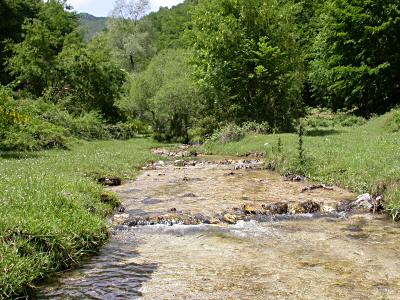
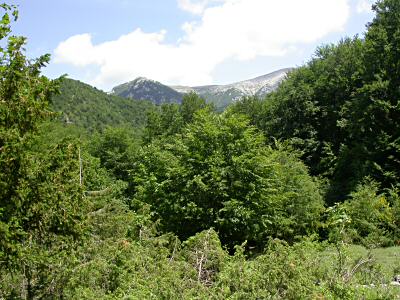
The best places around Rome:
Fiumata Valley (Springs of Aniene River)
 |
 |
| Fiumata: Aniene River near the spring- June | Fiumata: beech forest, 1200 m. - July |
Morphology - A small valley at about 1000 m. of altitude, surrounded by several calcareous mountains 1800-2000 m. high, in the Simbruini Mountains (Latium, 1,5 hour East of Rome). Fresh, humid, with many springs and brooks confluent in the Aniene River.
Vegetation - Near the river there are mostly Salix, MAGGIOCIODOLO and Acer, Rosa, etc., with several small lawns with little pasture of cows, full of flowers, especially Ranunculus, in Spring and the beginning of Summer. Valley's sides are mainly covered by a fine forest of Fagus sylvatica and Acer, with Juniperus and very few remnant of Taxus baccata hidden in the forest.
|
The Buprestid fauna is a typical mountain fauna, similar to that of Central Europe. The number of species is not high, but in the right season they are very abundant and there is an interesting presence: it is the only place in Latium (and one of the very few places in Italy) where it's possible to find Anthaxia midas oberthuri. (see image on the right) Larvae of this very beautiful species live in Acer spp., while adults feed on flowers of Ranunculus. |
|
Species usually possible to find there are: Acmaeoderella flavofasciata, Dicerca alni, Anthaxia chevrieri, Anthaxia istriana, Anthaxia mendizabali, Anthaxia midas oberthuri, Anthaxia millefolii polychloros, Anthaxia nitidula, Anthaxia semicuprea, Anthaxia thalassophila, Anthaxia umbellatarum, Chrysobotrhis affinis, Coraebus elatus, Coraebus rubi. There are also several species of Agrilus, mostly species living on Fagus, Acer, Salix and Rosaceae.
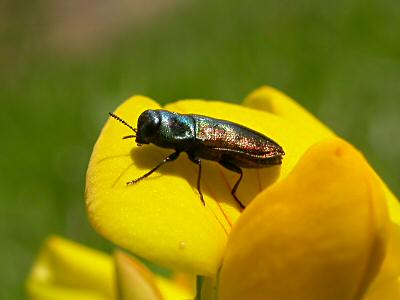 |
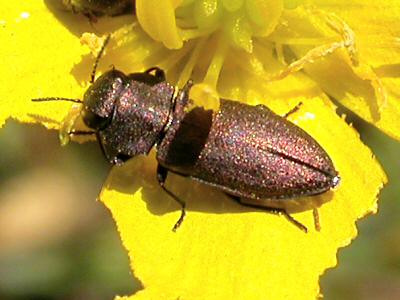 |
| Anthaxia thalassophila | Anthaxia istriana |
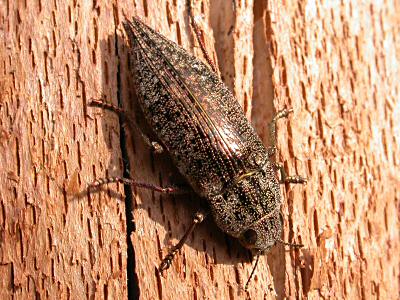 |
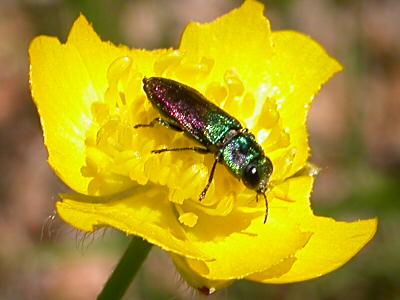 |
| Dicerca alni | Anthaxia semicuprea |
Maccarese, Bosco di Macchiagrande, etc.
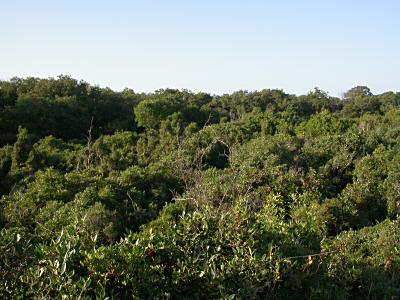 |
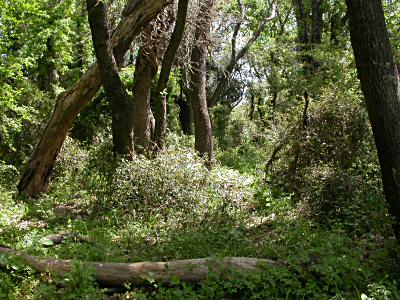 |
| Maccarese: macchia mediterranea and oak forest - November | Maccarese: inside the oak forest - May |
Morphology - A sandy lowland, with gravelly low hills, at few km from the Tyrrenian coast, at 30 minutes NW of Rome.
Vegetation - Remnant of a mediterranean wood; mainly an oak's wood, with bushes and pastures. High variety of trees and bushes of the Mediterranean Region, mostly Quercus ilex, Quercus suber, Quercus petraea, Pistacia lentiscus, Erica arborea, Phyllirea angustifolia, etc. Dumps, small stabilized sandy dunes near the seashore.
This place is not interesting for the presence of particularly rare Buprestidae, but for the large number of species and the long season when it's possible to find some of them (from March to november).
This is a list of species I found: Acmaeodera bipunctata, Acmaeodera quadrifasciata, Acmaeoderella adspersula, Acmaeoderella discoidea, Acmaeoderella flavofasciata, Acmaeoderella virgulata, Ptosima flavoguttata, Stigmatophorella (Rossiella) fabricii, Lamprodila mirifica, Capnodis cariosa, Capnodis tenebricosa, Capnodis tenebrionis, Latipalpis plana, Buprestis cupressi, Anthaxia chevrieri, Anthaxia confusa, Anthaxia deaurata, Anthaxia hungarica, Anthaxia hypomelaena, Anthaxia manca, Anthaxia millefolii polychloros, Anthaxia nigritula, Anthaxia nitidula, Anthaxia scutellaris, Anthaxia thalassophila, Anthaxia umbellatarum, Cnrysobothris affinis, Coraebus elatus, Coraebus florentinus, Coraebus rubi, Aphanisticus angustatus, Trachys coruscus, and a lot of species of Agrilus.
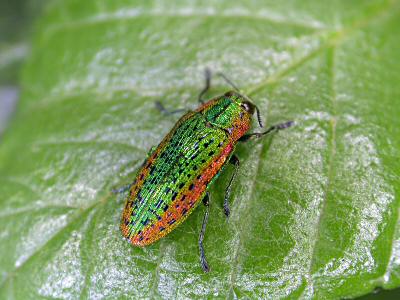 |
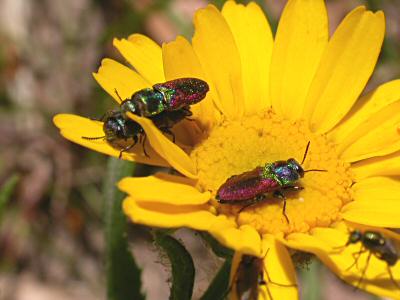 |
| Lamprodila mirifica | Anthaxia scutellaris |
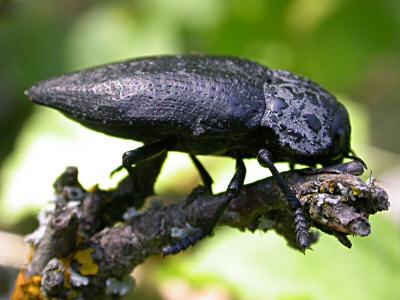 |
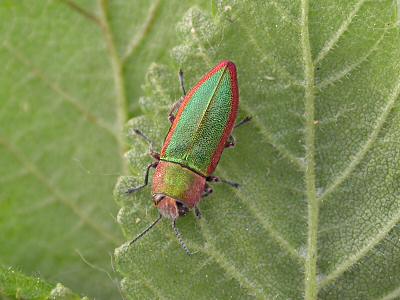 |
| Capnodis tenebrionis | Anthaxia senicula (= deaurata) |
Ostia - Castelfusano
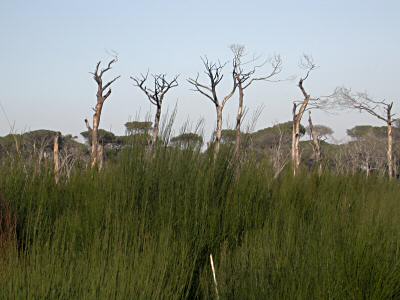 |
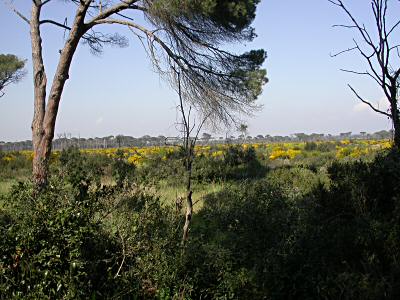 |
| What remains of the pine forest of Ostia-Castelfusano18 months after the fire - January | New vegetation growing and blooming on the burnt ground, 2 years after the fire - April |
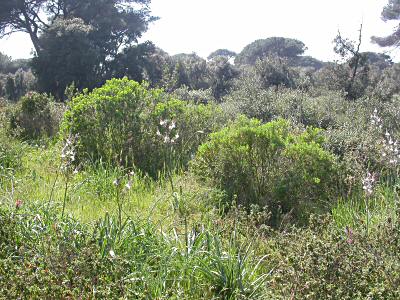 |
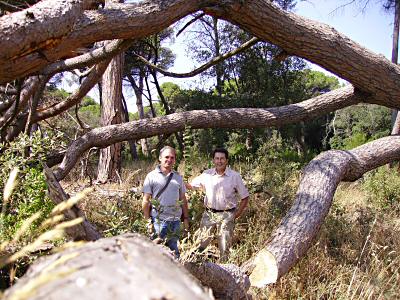 |
| Asphodelus and Euphorbia at the border of the pine forest - May | Inside the pine forest: Franco Tassi (right) and me (left) - August |
Morphology - A sandy lowland formed by the alluvial deposits of the Tevere river, near its mouth. At about 20 km SW of Rome.
Vegetation - An apparently natural pine forest. Indeed, the high and beautiful trees of Pinus pinea were anciently planted by Romans and then the pine forest was mantained for centuries, up to our days. The natural climax for this land had to be a forest dominated by Quercus ilex (or other Quercus where the ground is more dampness). Next to the sea there is this type of vegetation, and oaks also develop in the pine forest. Few years ago at least 4/5 of the ancient pine forest had burnt from a fire, and now just a strip remains near the road and a channel. The oaks' wood, instead, is almost entirely saved.
The Buprestid fauna is about the same of other good places near the coast of Latium, but with the addition of some species living on pine trees: Chalcophora massiliensis, Buprestis novemmaculata, Anthaxia nigritula, Chrysobothris solieri. Also the very rare Anthaxia hackeri, living on Ulmus, was found here.
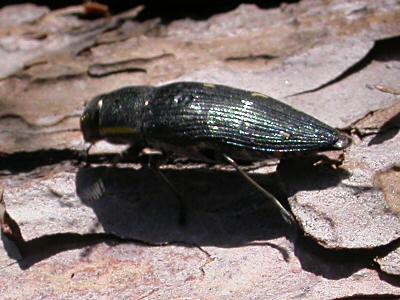 |
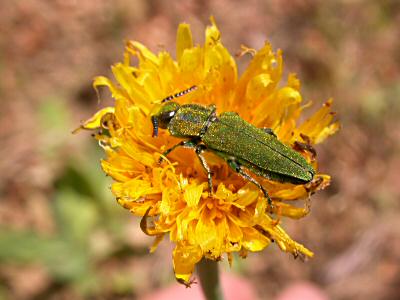 |
| Buprestis novemmaculata | Anthaxia hungarica |
Tolfa: Valle di Rio Fiume
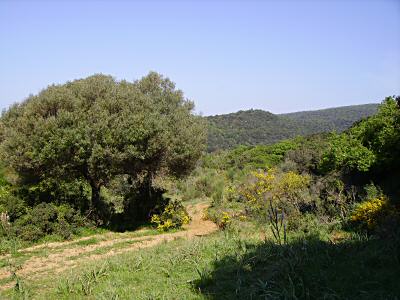 |
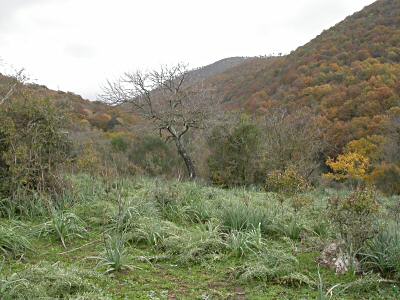 |
| Tolfa: the lower part of the valley of Rio Fiume - April | Tolfa: mid valley of Rio Fiume - December |
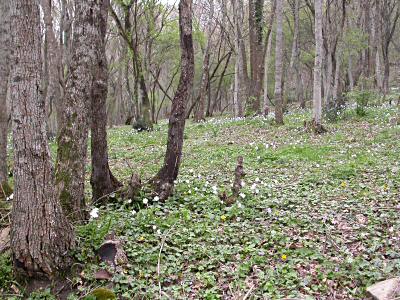 |
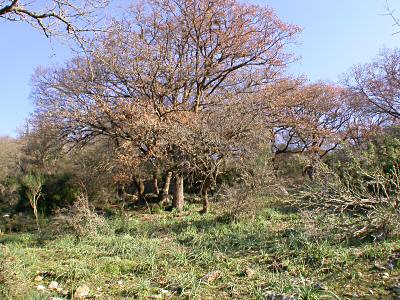 |
| Tolfa: Valle di Rio Fiume, wood of Carpinus and Acer - April | Tolfa: oaks with Kisanthobia ariasi - October |
Morphology - Ancient volcanic hills near the sea, NW of Rome, with a fine valley built by a small river (Rio Fiume), partially originated from thermal springs. From the sea level to few hundred meters.
Vegetation - Mediterranean wood and bushes near the sea, while temperate forests predominate toward the volcanic complex.; Vegetation is similar to that of Maccarese, but with more variety of species, especially for the addition of many Acer, Carpinus, Fagus, etc.
This is the best place to find Buprestidae in Latium, .and probably in the whole Central Italy, perhaps in Italy. Many species were found here, about the same of Maccarese, but with the addition of some interesting, rare or little know species, like Dicerca berolinensis, Kisanthobia ariasi, etc. However, it's not so easy to catch Buprestidae, here, because populations of most of species are quite small.
This is the complete list of species collected by me or other entomolgists:
Acmaeodera pilosellae, Acmaeodera degener quatuordecimpunctata, Acmaeoderella disoidea, Acmaeoderella virgulata, Acmaeoderella flavofasciata, Acmaeoderella adspersula, Ptosima flavoguttata, Sphenoptera antiqua, Chalcophorella fabricii, Capnodis cariosa, Capnodis tenebricosa, Capnodis tenebrionis, Perotis lugubris, Latipalpis plana, Dicerca aenea, Dicerca berolinensis, Lamprodila mirifica, Eurythyrea micans, Eurythyrea quercus, Kisanthobia ariasi, Melanophila cuspidata, Anthaxia hungarica, Anthaxia millefolii polychloros, Anthaxia umbellatarum, Anthaxia scutellaris, Anthaxia senicula (= deaurata), Anthaxia manca, Anthaxa salicis, Anthaxia semicuprea, Anthaxia suzannae, Anthaxia thalassophila, Anthaxia fulgurans, Anthaxia nitidula, Anthaxia hypomelaena, Anthaxia funerula, Chrysobothris affinis, Coraebus florentinus, Coraebus rubi, Coraebus elatus, Meliboeus violaceus, Nalanda fulgidicollis, Agrilus biguttatus, Agrilus obscuricollis, Agrilus angustulus, Agrilus graminis, Agrilus hastulifer, Agrilus convexicollis, Agrilus italicus, Agrilus aurichalceus, Agrilus integerrimus, Agrilus sinuatus, Agrilus roscidus, Agrilus viridicoerulans rubi, Agrilus elegans, Agrilus solieri, Agrilus pisanus, Aphanisticus emarginatus, Trachys troglodytes, Trachys coruscus
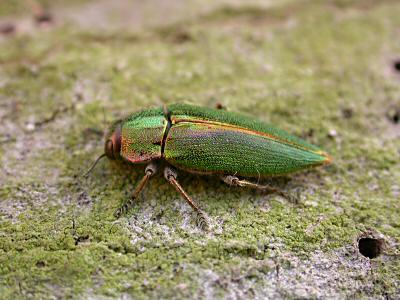 |
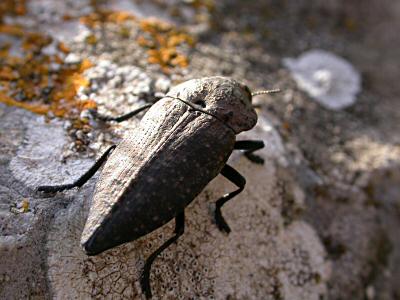 |
| Latipalpis plana | Capnodis tenebricosa |
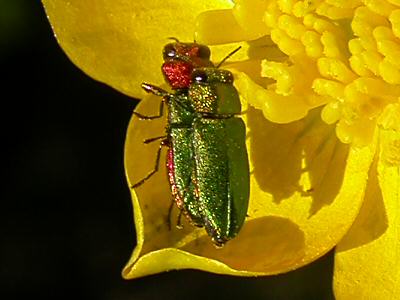 |
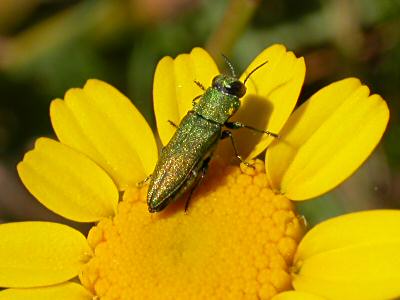 |
| Anthaxia nitidula | Anthaxia millefolii polychloros |
Hills around San Vittorino (Roma)
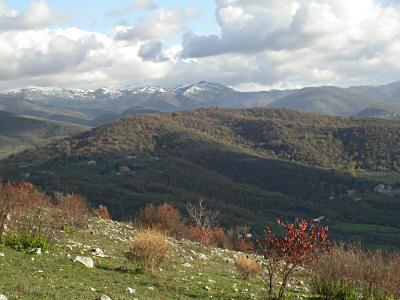 |
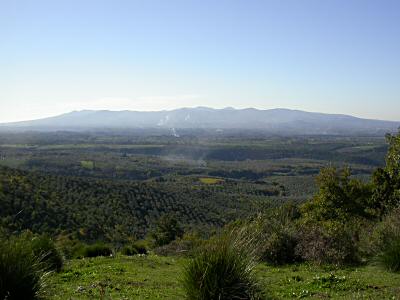 |
| San Vittorino Hills from Monte Ripoli - December | San Vittorino: olive groves in the background - November |
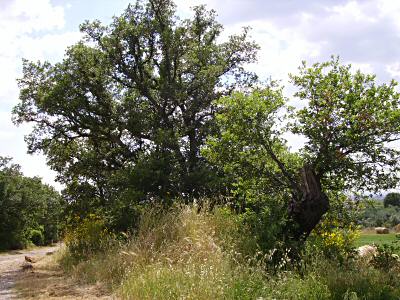 |
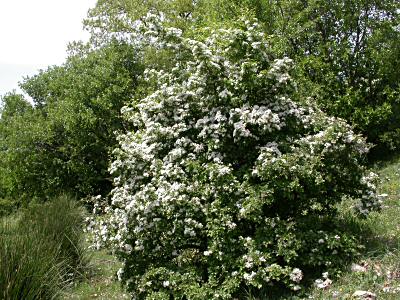 |
| San Vittorino: country road with oaks attached by Eurythyrea quercus - June | San Vittorino: blossoming Crataegus near a wood of Carpinus - May |
Morphology - Hills at the base of the pre-Appennines the NE margin of the Roman countryland. Giurassic calcareous hills rising from a tufaceous lowland
Vegetation - Woods of Carpinus on the Estern side, Quercus pubescens and Fraxinus ornus on the Southern side of the hills. Mixed woods, mostly with Quercus spp.and Celtis australis in the lowlands, mixed with cultivated areas (mostly almond and olive groves, wheat). Several woods growing on abandoned olive-groves. Many Prunus, Pyrus, Crataegus, Cerceris siliquastrum, Styrax officinalis, etc. everywhere.
This is an apparently meaningless and uninteresting place, but it is really very interesting for the good number of species and for the presence of some rare species.
This is the list of species collected by myself or which I observed the traces of: Ptosima flavoguttata, Acmaeodera pilosellae, Acmaeoderella virgulata, Acmaeoderella adspersula, Acmaeoderella flavofasciata, Chalcophorella fabricii, Capnodis tenebrionis, Capnodis tenebricosa, Capnodis cariosa, Latipalpis plana, Sphenoptera antiqua, Sphenoptera laportei, Dicerca aenea, Dicerca berolinensis, Eurythyrea quercus, Eurythyrea micans, Buprestis cupressi, Anthaxia hungarica, Anthaxia manca, Anthaxia salicis, Anthaxia suzannae, Anthaxia thalassophila, Anthaxia fulgurans, Anthaxia chevrieri, Anthaxia mendizabali, Anthaxia umbellatarum, Anthaxia millefolii, Anthaxia scutellaris, Anthaxia cichorii, Chrysobothris affinis, Coraebus florentinus, Coraebus rubi, Coraebus elatus, Agrilus sinuatus, Agrilus viridicaerulans rubi, Agrilus marozzinii, Agrilus auricollis, Trachys coruscus, Trachys minutus.
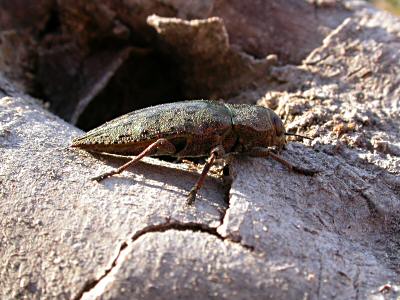 |
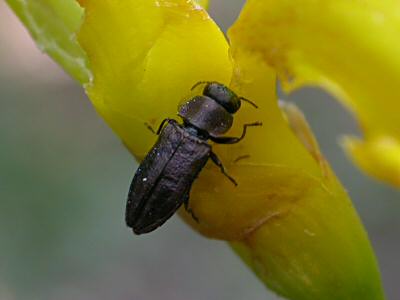 |
| Dicerca berolinensis | Anthaxia mendizabali |
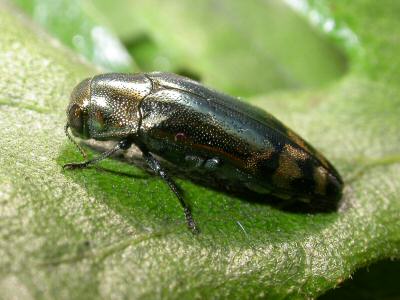 |
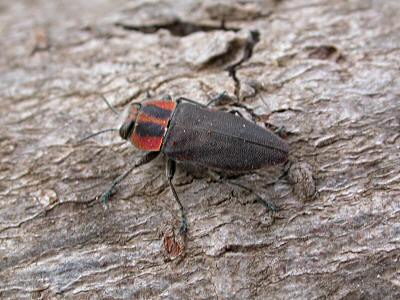 |
| Coraebus florentinus | Anthaxia manca |
Supino (E. Lepini Mountains)
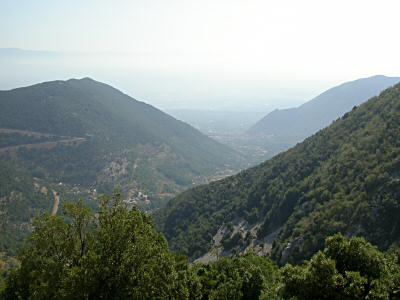 |
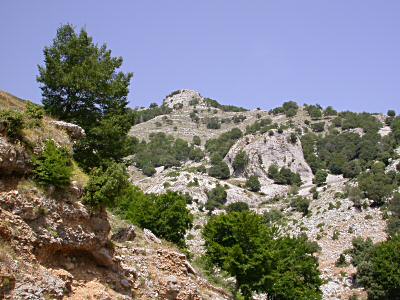 |
| Toward the village of Supino, woods of Quercus ilex - August | Toward the top of the mountain, the first Fagus sylvatica - August |
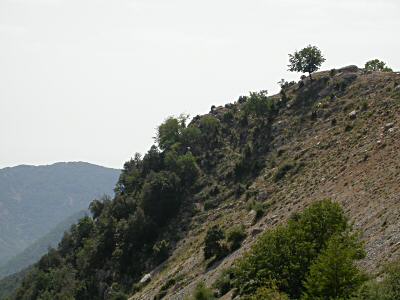 |
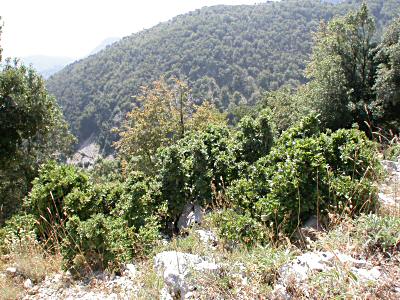 |
| A slope with SE exposition, with Quercus ilex and Ostrya carpinifolia - July | Small bushes of Quercus ilex on the top of a rocky slope - July |
Morphology - Just above the Supino village (Southern Latium). A small valley on the oriental side of the Jurassic Lepini Mountains, with steep calcareous slopes. covered by thick vegetation (mostly Quercus ilex on the most exposed sides, Ostrya carpinifolia elsewhere; Fagus sylvatica over 1000 m a.s.l.
Vegetation - The most exposed slopes are covered by thick vegetation of Quercus ilex, with Ostrya carpinifolia elsewhere and Fagus sylvatica over 1000 m a.s.l. Most of the Quercus ilex, growing on very poor soil, are represented by bushes or small trees. Salvia officinalis is also quite common.
There is the typical fauna of mediterranean woods of Quercus ilex. On this evergreen tree live two interesting and very rare (at least in Italy) species: Coraebus undatus and Agrilus curtulus. I found one specimen of the first one flying from a small bush of Q. ilex to another, and some specimens of the second one on leaves of trees at the beginning of August. Other species living on oaks are the same found on other places. I din't find anything of special interest on beech trees (the usual fauna with Agrilus spp., Chrysobothris affinis, Dicerca alni), while there are exit holes of the apparently rare species Dicerca berolinensis on trunks of Ostrya carpinifolia.
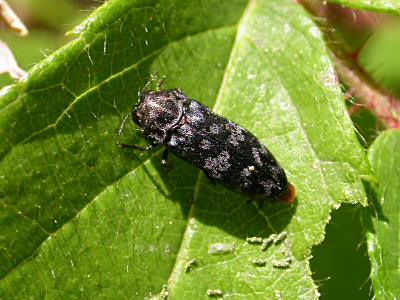 |
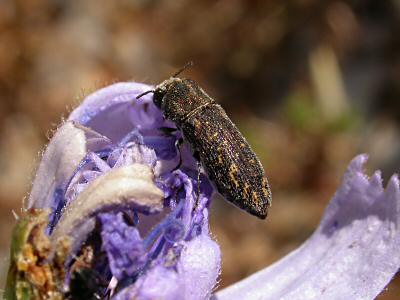 |
| Coraebus rubi | Acmaeoderella adspersula |
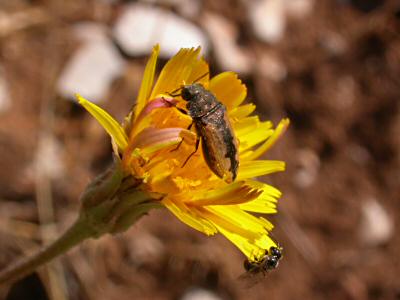 |
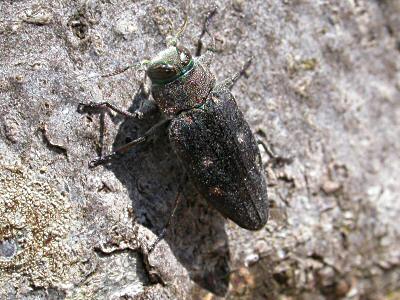 |
| Acmaeodera pilosellae | Chrysobothris affinis |
Other interesting places around Rome:
|
Parco Talenti, Parco della Cervelletta, etc. Scarce rests of the native vegetation of the Roman countryland survive in Rome and in its immediate proximities. Some of them are characterized by vegetation of humid places, originally well developed along all the brooks of the country. Unluckily, most of these brooks, locally named "marane", where completely dried or canalized in buried pipings. The few survived brooks show a vegetation mostly composed by Salyx, Populus, Ulmus, Quercus, etc., sometimes Alnus, and several herbaceous plants. Most of the Buprestids living on these trees and herbs can be found there: Dicerca aenea, Eurythyrea micans, Poecilonota variolosa, Lamprodila mirifica, Trachypteris picta decostigma, Anthaxia deaurata, Anthaxia manca, Agrilus ater, Agrilus lineola, Agrilus suvorovi populneus, Agrilus pratensis, Trachys lictensteini, Trachys minuta, Trachys puncticollis rectilineata, Trachys scrobiculata, Trachys troglodytiformis. The most xeric places show an interesting fauna living on herbs (Sphenoptera) and tree-like Rosaceae. Very interesting is a specimen of Anthaxia candens found several years ago by another Roman entomologist (Gianni Gobbi) in a place totally destroied about 20 years ago. It's the only specimen found in Central and Southern Italy. I recently found (2006) exit holes of the same species in a cherry tree in the garden of a clinic not far from the first place. |
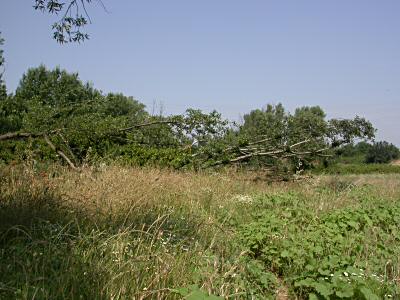 Poplars beaten down by a small tornado in the Urban Park of Cervelletta - June |
|
Nettuno: Bosco dell'Acciarella One of the very few natural humid woods of oaks survived in the lowland South of Rome, near the sea. The whole land going from the mountains (Colli Albani, Monti Lepini, Monti Ausoni) to the Tyrrenian Sea, in the Southern Latium, was previously a marshy zone, infested by mosquitos and malarial fevers. It was drained before the Second World War, and now it is predominantly cultivated. Many Buprestids of the oaks live in this fine wood, probably almost all those living of central Italy. Many Agrilus and Coraebus florentinus are especially common here. Dicerca alni is also very common on Alnus glutinosa, near the ponds. Several old oaks let think Eurythyrea quercus could live here, too. |
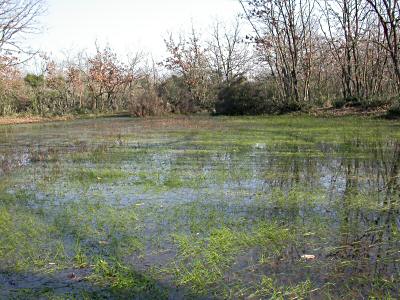 Bosco dell'Acciarella: one of the small ponds in the wood of oaks - January |
|
Cineto Romano A small valley among the mountains NE of Rome, near the village of Cineto Romano, with a temporary creek a very rich and varied vegetation (Populus, Salyx, Ulmus, Quercus, Fraxinus, Acer, Corylus, Carpinus, etc.). Many species of Buprestidae can be found here, especially in May, most of them visiting flowers (Anthaxia, Acmaeodera, Acmaeoderella). Some of the Salyx growing near the creek are damaged by larvae of the rare (in Italy) Lamprodila dives. Anthaxia hungarica and other species in this genus are extremely common. |
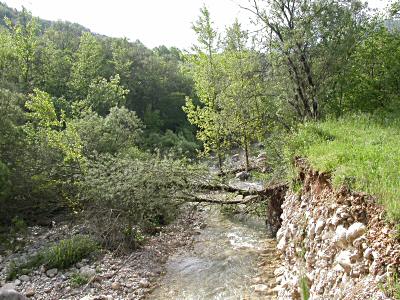 The small valley near Cineto, with the creek - May |
|
Collegiove - Marcetelli: woods of Castanea sativa Near the border with Abruzzo, NE of Rome, a very large forests of Castanea sativa with many Quercus, Sorbus, Prunus, etc. at about 1000 m a.s.l. A good variety of species of Buprestidae. I didn't find anything particularly rare or strange, but I think that probably there is some Eurythyreas quercus living in the enormous trunks and main branches of the secular chestnut trees. Many small species can be found on flowers in the rare small clearings, while on dead trunks of Castanea I found only common Agrilus and the very common Chrysobothris affinis. |
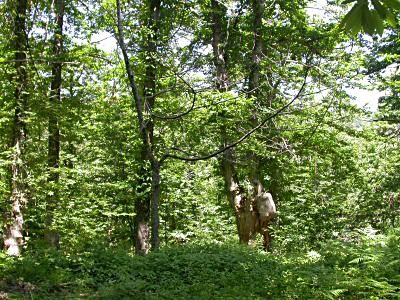 Chestnut forest near Marcetelli |
|
Valle del Fiume Fioio Not far from Fiumata, this very fine valley, at about 1200 m. a.s.l., half in Latium and half in Abruzzo, is one of the very few places where it's possibile to find trees of Abies alba in my region. They are scattered in a beautiful wood of beech trees, together with few pine trees and many maples. In the middle of the valley there are several very old wild apple trees. The Buprestid fauna is quite similar to that of Fiumata, but I never was able to find Anthaxia midas oberthuri (but probably it lives here, too). However, there is a species coming from conifers, probably from Abies alba: Anthaxia liae, endemic of Southern Italy, but recently found also in Abruzzo (it wasn't known for my region).It is not rare on flowers of Ranunculus during the Summer, together with many Anthaxia semicuprea. |
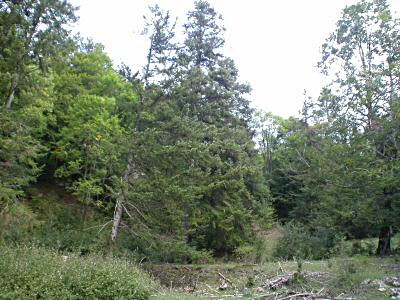 Fioio Valley with Fagus sylvatica and Abies alba |